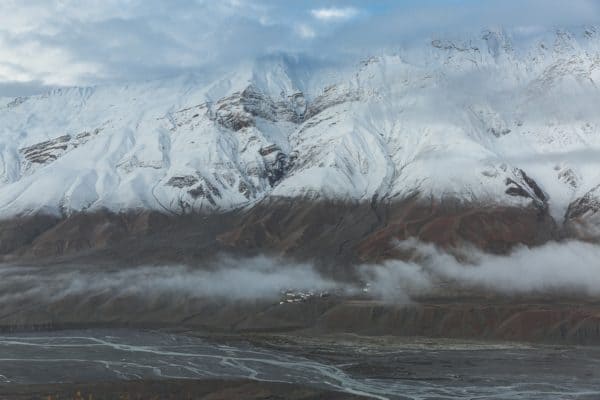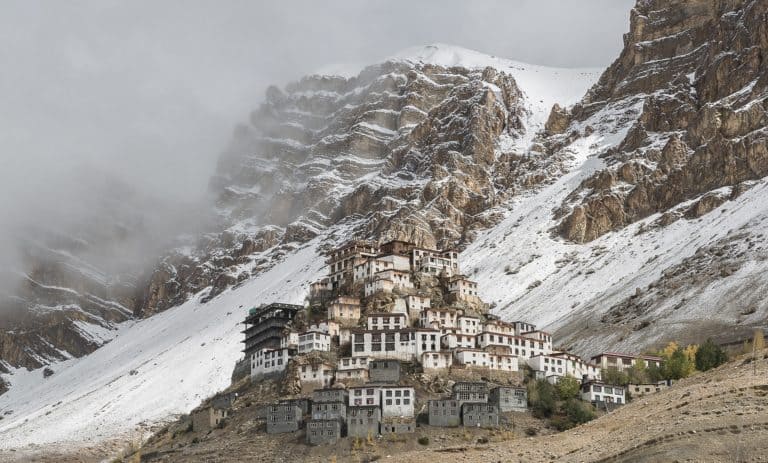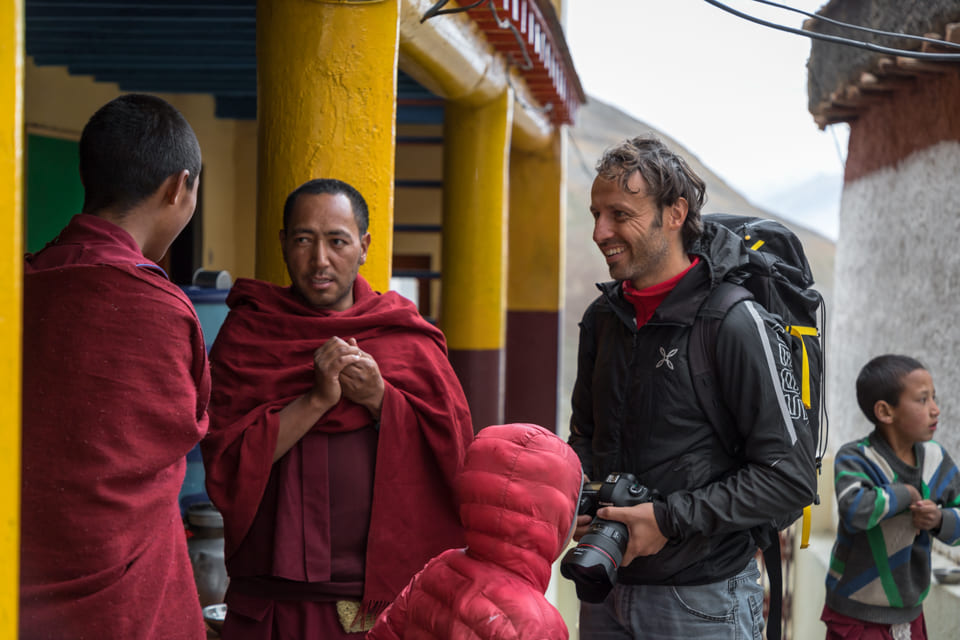This is how it happens in Spiti Valley, without warning, on 22 September 2018. I woke up early and the bright gray landscape that yesterday occupied the view, today, is covered with a white blanket, wet and beaming with sleet and snow.
The guys from the guest house where I was staying had already called the Reckong Peo weather station, and the response from there was simple. They say it will last three days, “rain and snow without a break”.

Bad weather is a rare occurrence in Spiti in September. At most, some evening flurries arrive, in a matter of a few hours; the stars return to take over the sky.
That day it was not the case, and it seemed like it’d last longer. The disturbance—which has gone down in history as the most intense since the beginning of the millennium—was triggered by the cyclone which reached the Odisha coast. Its effects extended into much of the Indian subcontinent.
In sunny conditions, I’d have moved to higher altitudes, but the bad weather forced me to review my schedule.
I could use the hotel room until noon, and I did not intend on extending my stay in Kaza (or Kaja). I had been here for three days now, it was the time for a change of scenery.
Weathering the storm
Outside the window it was freezing cold; it was pouring rain, and two hundred meters higher the snow had now blanketed the slopes.
I was struck by the level of tranquillity to which the main city of Spiti, located at 3790 meters above sea level, had fallen.
It seemed immobile, inanimate, despite the presence of several hundred seasonal migrants and as many travellers who were visiting the valley at that time.
I can only imagine the desolation in the colder months, when winter envelops every space with its blanket of snow.
In January, they told me, the mercury drops to -25 °C, if not more. I have admiration for the permanent inhabitants, especially for those who live in villages at high altitudes, well above four thousand meters, where temperatures of -40 °C are not uncommon.
How many privations, how many difficulties one can endure in facing winters without water, little food and blocked roads?
“In these parts, if someone gets sick in the winter, we have to transport them to Kaza on a yak.” Tenzin later confided in me, during a nice evening chat, in his house in Komik (or Komic) village.
“Then from Kaza to get to a real hospital there are another two days of travel, up to Shimla,” assuming the roads are open.
The sudden bad weather helped me to identify with those who live—in some periods, just survive—here. The stillness caused by wind and rain was evident, especially in the dogs, stationed day and night in strategic areas of the village.
They found a dry space and were dozing off regardless of what was happening around them, like under a canopy where I sought shelter from the rain.
An old stray dog got up, came to smell me, then went back to snug in the same position held for hours. I was happy to have been allowed near the pack, although I wondered how they survived through the colder months.
Perhaps in winter, some kind-hearted person would take care of them. I greeted them and walked along the main road, where an open door led me to a food joint serving hot tea.
I began to reflect on what to do. Before planning anything, I had to go to the bus station and find out if vehicular traffic was running. The road to the Rohtang pass—the only way to Manali at that time—was blocked by snow. They said it will take at least five days to clear the snow and if snow kept falling, jeeps, motorcycles, trucks, and public transport would have to wait for the arrival of spring. The alternative was descends towards the Kinnaur, where at the moment it rain was falling.
Landslides and mudslides had wiped out entire stretches of road. From the slopes upstream of the road, boulders, about the size of an SUV car, slid down from time to time.
This meant that hundreds of travellers, Indian and foreign, found themselves stranded in the capital of Spiti – Kaza. Airplanes do not arrive in this part of the world; therefore, even those who had a return flight from New Delhi had to reschedule their departure.
All that was left was returning to the room, turning your thumbs in anticipation of “enlightenment” and a good idea to make sense of the isolation imposed by the storm. One has to stay in a safe place.
Higher up, snow had isolated the villages of Hikkim, Langza, Komik, and Demul. The only tracks still passable led to the village of Mud, in the valley of the River Pin, or to Key (otherwise called Ki Gompa) monastery; the most important Buddhist monastery in Spiti, on the way to the village of Kibber.
People were looking for the forecast of the weather, the status of the roads and if any buses were departing – I was stuck in Spiti, waiting for good weather.
Certainly, this disturbance ruined any chance of climbing Mount Kanamo, which towers over the village of Kibber from a height of 5,963 meters. It was on the things-to-do list of my trip.
Finding a refuge in Key monastery
At the end of the stream of thoughts that lasted for three cups of tea, I decided to leave Kaza and spend the “storm of the decade” elsewhere. Going to Key (or Ki) Gompa (monastery) was the right choice; after all, I would have gone there anyway, to see it again, about more than a decade after the first visit, which remained long in my memories.
The obligatory stay (imposed by the storm) allowed me to closely observe one of the most venerated monastic institutions in Himachal Pradesh.
At the Key Gompa there is a dormitory reserved for pilgrims and travellers. The important thing was to adapt, to bear the cold—around 3 °C inside the dormitory—and the continuous falling of the snow on the roof.
The monastery is located 15 kilometers from Kaza, on a hill at 3800 meters above sea level on the slopes of Mount Dagmachan (5157 meters). About 350 monks of the Gelukpa sect lived and studied there.
The entire structure is dedicated to Lochen Tulku, the twenty-fourth reincarnation of the translator Lotsawa Rinchen Zangpo. Originally, the monastic complex stood in a village on the other side of the Spiti river (near village Khurik), but after continuous raids, in the 11th century it was moved to this hill due to security concerns.
Related: Exploring Spiti Valley through backpacking and hiking
Inside the Key monastery
At Key Monastery, there is a collection of ancient sacred texts and Thangka – Buddhist paintings on cloth. On the interior walls are frescoes with stories taken from the Jātaka, tales of the Buddha’s previous lives.
The upper part of the complex houses the actual monastery, where lamas and monks gather to pray every morning. In the same structure there is a library and the cells of the elder monks, then a smaller prayer room, used by a single monk, in charge of keeping the demons at bay.
Not far away, an old wooden door leads into the belly of the mountain, inside the meditation cells carved into the rock. The top of the Key Gompa is occupied by an open concrete space, intended for common activities, at least when the sun is shining.

In the days of snow and cold, the focal point of the monastery was the kitchen, where two monks were in the charge of preparing three meals a day.
We were served Tsampa – a mixture of salt tea with butter combined with barley flour. Breakfast was served in the hall of the main temple, where the Tsampa was served while the monks recited the morning sermons. Foreigners are also allowed, as long as they do not take pictures and sit at slots reserved for guests.
Savouring Tsampa
The younger lamas are responsible for serving the tea and distributing the Tsampa (pronounced sam-pa or साम्पा in Hindi) flour. To prepare the dough, a precise ritual is followed, which I only learned the third day.
Salted tea with butter and a few spoonfuls of Tsampa flour is poured into a bowl which was as low and wide as a palm; then, with the fingertips of the right hand, the flour is mixed with the tea.
The process continues for several minutes, until the preparation becomes uniform, and it can be rolled into small balls.
My inexperience in making the Tsampa balls was self-evident. Initially, the ratio of tea and flour was unbalanced, so I put my index finger in the broth. I tried to fix it by adding more barley flour, but I got the opposite effect. On the third attempt, I succeeded.
It is always a question of balance. Buddhism (the Middle Way) also teaches this. The same is true for simple things, such as the preparation of the Tsampa, which every morning delivers the handy way teachings.
Contemplating the days
During my stop at the Key Monastery, I spent long hours in the monastery kitchen, sitting with the lamas in front of a huge fire. The fire was fed by large logs of wood. The walls were lined with a thick layer of black soot.

The place gives a feeling like it always existed, for at least a million years. There, the days passed at the speed of a few hours. Soon, I learned how to adjust to this new passage of time. I started climbing the stairs slowly and found peace in watching the sun rise and set over the horizon.
I also got used to standing still, for twenty minutes or more, without saying a word. Passive observation was enlightening; it allowed me to listen to the measured conversations of the lamas.
At Key Gompa, the rhythm of the talks is slow. No fast-paced conversations like a tennis match, there we conversed like in chess, one move after another, keeping with the slow pace of reflection.
No, I’m not the victim of a naive spiritual drift. I’m just optimizing resources; I want to empathize with a world, and that of the monastery, light years away from the Veneto where I come from.
I knew that tomorrow (or the next day), I would resume my journey and all this would somehow disappear. So I tried to savour every moment, to grasp the essence of this unique place.
- I Stayed in Key Monastery for 3 Days (and Savoured Tsampa) – September 22, 2022


Leave a Reply